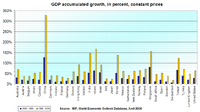
Photo from wikipedia
The growth of China, India and other countries in the Global South over the past decades has led to a relative catching up with the already industrialised economies of North… Click to show full abstract
The growth of China, India and other countries in the Global South over the past decades has led to a relative catching up with the already industrialised economies of North America and Europe. This translates into a reduction in global inequalities, in the sense that the gap between average living standards between the two categories of economy is no longer as great as it once was. However, this disguises what has been a global phenomenon of increased inequality of wealth and income within almost every country on earth. Thus, inequality has grown within China, within India, within the U.S., within the UK, and so on. So, any reference to reduced inequality globally needs to bear in mind this reality – of increased inequality facing people within their own country. In ‘Structural change and industrial linkages: a perspective on China’s growth pattern, 1995–2009’, Roberto Alexandre Zanchetta Borghi notes that ‘China has presented one of the most noticeable growth experiences in economic history’, with the high economic growth rates in the post-1978 reform era having been marked by deep structural changes. The paper analyses these changes from a Kaldorian-Structuralist perspective, emphasising ‘the importance of a large, diversified and integrated industrial base as a central engine of economic growth’ – which Borghi suggests, prevented balance-of-payments constraints, with most sectors having been able to generate through exports sufficient foreign exchange to pay for the required imports. In terms of the future for countries of the Global South – to go further in economic development, poverty reduction, and even perhaps reducing the inequalities in wealth and income that has been created over the past decades – an important role may be played by financial inclusion. In other words, ensuring that the less well off in these societies can gain access to basic financial products and services in a cost-effective matter. A review of the literature in this area, regarding the factors responsible for financial exclusion, policy initiatives by government and regulatory bodies, and recent trends regarding financial inclusion, is reported by Anusha Goel, in ‘Trends and reforms of financial inclusion in India’. While the literature does report progress in many aspects, as far as India is concerned, the overall picture is one of work in progress, with various challenges still faced, and needing to be overcome. Along with financial inclusion, development requires an effective productive infrastructure – including transport, communications, energy, and water and hygiene. This aspect is analysed by Isaac Ketu and Paul Ningaye in ‘Does Infrastructure Development Matter for the Shadow Economy in African Countries?’. Analysing 42
Journal Title: International Review of Applied Economics
Year Published: 2023
Link to full text (if available)
Share on Social Media: Sign Up to like & get
recommendations!